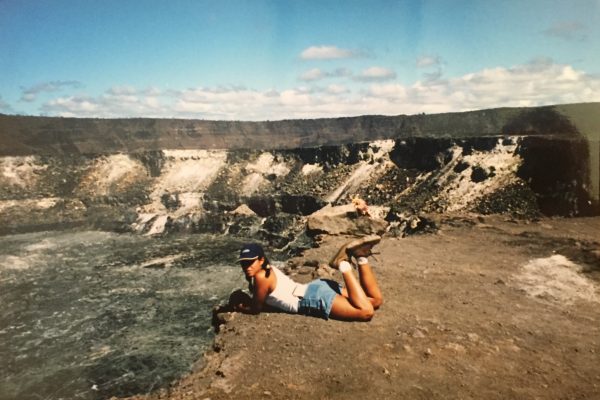I was eight years old when lava fountains from Kīlauea Volcano began building a cinder and spatter cone hundreds of feet high, spewing thick, chunky lava that later wiped out the towns of Kalapana and Kaimū on Hawaiʻi Island. More than 100 homes, a church and a store were buried beneath 50 to 80 feet of cooled lava.
The images that flashed on TV during the local newscast back then were both frightening and mesmerizing. I couldn’t tell you anything else that happened in 1983.
A decade later, I found myself standing on a rocky ledge above the Pacific Ocean, under a canopy of stars, the soles of my hiking boots tacky from the heat of the lava surging beneath us. You could taste the thick, sulfuric heat. The only light illuminating our dangerous trek came through the cracks in the ground, the incandescent orange glow of lava flowing from Pu‘u ʻŌʻō vent, under this crust of harden lava, toward the ocean.
I stood there, watching 2,100-degree molten lava flow into the churning ocean, sending steam plumes into the dark sky. I was witnessing the birth of land, the physical growing of the island where my mother was born. Here was the newest landmass in a solar system that’s more than 4 billion years old. It was as humbling as it was surreal.
At the time, I was attending the University of Hawaiʻi at Mānoa, schizophrenically majoring in both English and geology. It felt like dating two guys who have nothing in common: I was committed to the preppy path of nonfiction prose and composition pedagogy, but I was completely smitten by the rugged allure of planetary volcanism and plate tectonics. While I spent most of my time in college penning critical analyses of important literary works, I snuck out on weekends to hike around craters and through lava fields. Books ignited my imagination, but geology made it all tangible and real.
I was chaperoning a Geology 101 weekend field trip to Hawai‘i Volcanoes National Park, a 323,431-acre expanse of land that spans various climates and encompasses two active volcanoes, including Kīlauea, the world’s most active. Like the National Park Service, this national park, one of five on Hawai‘i Island alone, is celebrating its 100th anniversary this year.
Six of us had decided to meet after dinner, “borrow” the rental van, and hike across a lava field at the end of Chain of Craters Road, where we knew lava was pouring into the ocean. We had grabbed a bottle of whiskey and picked some ‘ohelo berries to offer to Pele, the volcano deity who resides in Halema‘uma‘u Crater, you know, just in case.
We chatted excitedly on the drive there, the adrenaline coursing. We had just snuck out of the dorms at the Kīlauea Military Camp with backpacks stocked with water, extra jackets, gloves, flashlights, snacks and Band-Aids. Seeing the lava flow at night would be an unforgettable experience—and we weren’t going to miss it.
The hike to the flow was treacherous, even with headlamps and flashlights. The landscape, desolate and wild during the day, was even more barren at night. We walked to the rhythmic sound of harden lava crunched with each step, trying to avoid the deep crevices that often occur as lava cools. It was like walking on glass.
The heat was heavy and palpable, rising from the cracks beneath us. I could feel the warmth and intensity through the thick soles of my hiking boots. I wondered how close the lava was to the surface of rock I was walking across—and whether we should have listened to our geology professors and stayed in bed.
We walked for miles, now in silence as we struggled to steady our footing and navigate our way to the ocean. We could only hear the gentle crashing of the waves somewhere off in the pervasive dark.
After what seemed like hours of walking, we stopped at a ledge and just gazed, completely enthralled, at a steady flow of lava cascading into the ocean below. The crackling of fire, the glowing red waves, a sky blanketed in twinkling specks of light—these remain some of the most indelible images I have in my mind. It was a quiet drive back to the camp.
Though I have hiked through the park dozens of time since then, I have never returned at night. It’s a gift to see the lava in such a peaceful and personal way. And one gift like that is enough for a lifetime.





2 Comments
One of your best posts….
Your remembering one of your Volcano trips reminds me of the times my family would hike out to “see the lava!” Thanks for reminding me of those amazing trips from my growing up there! I love the way you write – you bring it to life!